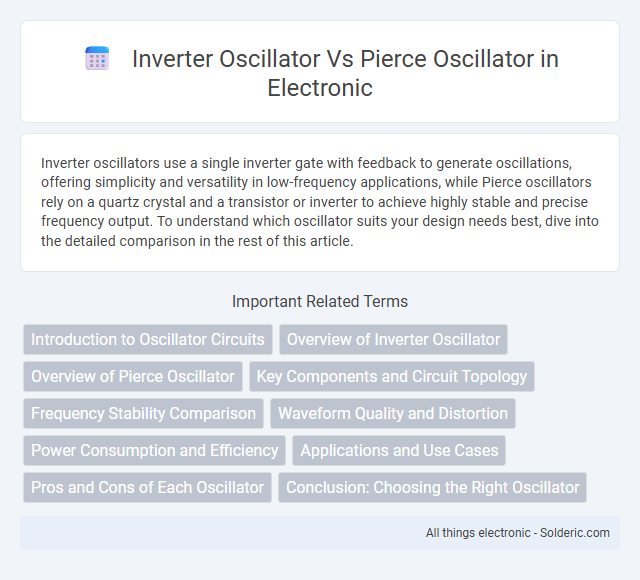Inverter oscillators use a single inverter gate with feedback to generate oscillations, offering simplicity and versatility in low-frequency applications, while Pierce oscillators rely on a quartz crystal and a transistor or inverter to achieve highly stable and precise frequency output. To understand which oscillator suits your design needs best, dive into the detailed comparison in the rest of this article.
Comparison Table
| Feature | Inverter Oscillator | Pierce Oscillator |
|---|---|---|
| Basic Principle | Uses a digital inverter gate as the amplifying element | Utilizes a transistor or inverter with a crystal feedback network |
| Frequency Stability | Moderate stability, depends on passive components | High frequency stability due to crystal control |
| Common Applications | Clock generation, simple timing circuits | Precise frequency generation in clocks, radios, and communications |
| Complexity | Simple design, fewer components | More complex due to crystal and feedback network |
| Output Waveform | Square wave | Sinusoidal waveform |
| Frequency Range | Wide, depends on components and gate speed | Narrow, set primarily by crystal frequency |
| Power Consumption | Low to moderate | Low, efficient crystal operation |
Introduction to Oscillator Circuits
Oscillator circuits generate continuous waveforms essential for clocks, radios, and signal processing. An inverter oscillator uses a digital inverter with feedback components to produce oscillations, leveraging the inverter's switching action for simplicity and low power. Pierce oscillators employ a crystal and transistor-based amplifier, offering higher frequency stability and precision ideal for timing applications where your design demands accuracy.
Overview of Inverter Oscillator
Inverter oscillators utilize a single CMOS or TTL inverter gate combined with feedback components, such as resistors and capacitors, to generate stable oscillations at a specific frequency. This simple oscillator design is widely used in integrated circuits for clock generation due to its low power consumption and ease of implementation. The frequency stability and waveform quality depend heavily on the inverter gain and external feedback network parameters.
Overview of Pierce Oscillator
The Pierce oscillator is a widely used crystal oscillator circuit known for its simplicity and stability, relying on a quartz crystal to control frequency with high precision. It typically uses a single inverter and a pair of capacitors to form a feedback loop that maintains oscillation at the crystal's resonant frequency. Your applications benefit from the Pierce oscillator's low phase noise and cost-effective design compared to other oscillator types such as inverter oscillators.
Key Components and Circuit Topology
The inverter oscillator primarily consists of a digital inverter gate, feedback resistor, and a capacitive network, forming a simple ring or RC phase shift circuit that generates oscillations. In contrast, the Pierce oscillator incorporates a quartz crystal, two capacitors, and an inverter or transistor, leveraging the crystal's high-Q factor to ensure precise frequency stability. Your choice depends on the required frequency accuracy and circuit simplicity, with the Pierce oscillator offering superior frequency control due to its crystal component.
Frequency Stability Comparison
Inverter oscillators typically exhibit lower frequency stability due to their reliance on digital logic gates, which can introduce jitter and temperature-dependent variations. Pierce oscillators leverage quartz crystals, providing superior frequency stability with minimal deviation under varying environmental conditions. The crystal's high quality factor (Q) in Pierce oscillators ensures precise and consistent oscillation frequencies, making them ideal for applications requiring exact timing.
Waveform Quality and Distortion
Inverter oscillators typically produce square wave outputs with higher harmonic distortion due to their digital switching nature, making them suitable for clock generation but less ideal for low-distortion signals. Pierce oscillators generate sinusoidal waveforms with superior quality and minimal distortion, leveraging crystal feedback to maintain frequency stability and signal purity. For applications demanding clean and stable waveforms, your design should prioritize Pierce oscillators over inverter types.
Power Consumption and Efficiency
Inverter oscillators typically consume more power due to continuous operation of the CMOS inverter in the feedback loop, resulting in moderate efficiency for low-frequency applications. Pierce oscillators, leveraging a crystal or quartz resonator, offer superior frequency stability and lower power consumption, making them highly efficient for precision timing circuits. Efficiency in Pierce oscillators arises from minimal active device switching and the high Q-factor of the resonator that reduces energy loss.
Applications and Use Cases
Inverter oscillators are widely used in digital circuits for generating clock signals due to their simplicity and ease of integration with CMOS technology. Pierce oscillators are preferred in low-frequency applications such as crystal-controlled clock generation in microcontrollers, offering high frequency stability and low phase noise. Both oscillators find applications in timing circuits, but Pierce oscillators excel in precision timing devices like watch oscillators and RF communication systems.
Pros and Cons of Each Oscillator
Inverter oscillators offer simplicity and ease of design, making them ideal for low-frequency applications, but they tend to have higher power consumption and more phase noise compared to other types. Pierce oscillators provide superior frequency stability and low phase noise, which is essential for precision RF and clock circuits, though their design complexity and component selection are more critical. Your choice depends on balancing factors like stability, power efficiency, and design complexity based on the specific application requirements.
Conclusion: Choosing the Right Oscillator
Selecting the right oscillator depends on specific application requirements such as frequency stability, load sensitivity, and power consumption. Inverter oscillators offer simplicity and low power usage, making them suitable for integrated circuits, while Pierce oscillators provide higher frequency stability and are preferred in precision timing applications. Evaluating factors like output waveform purity and environmental susceptibility ensures optimal performance for targeted electronic designs.
Inverter oscillator vs Pierce oscillator Infographic

 solderic.com
solderic.com